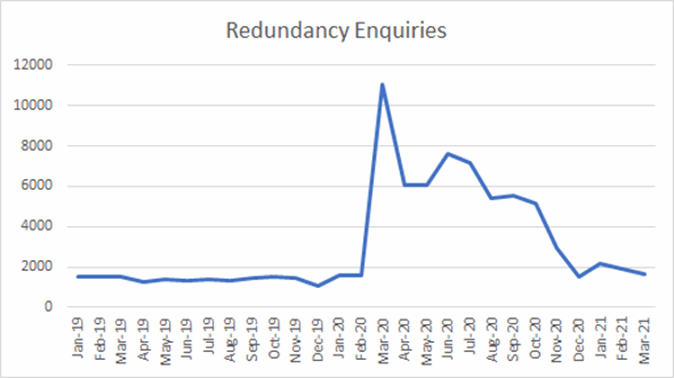It’s over a year since the first cases of coronavirus hit the UK. Since then, life has been turned upside down for many of us.
The first national lockdown was announced on 23 March 2020 and brought with it many restrictions on everyday life in an attempt to keep people safe.
Those restrictions have meant a lot of change for people’s working lives. Businesses have been forced to close or move to a remote workflow.
At Peninsula, we have been providing employment law and HR advice services since 1983 and have seen first hand how thousands of businesses have handled the pandemic.
We’ve provided coronavirus business advice to countless clients on how to navigate these changes and make the difficult employment decisions that have arisen.
In this guide, we have reviewed the different types of questions we’ve been asked as well as data from the Office of National Statistics (ONS) to present UK coronavirus stats and show the coronavirus business impact.
Furlough statistics
The furlough scheme, officially known as the Coronavirus Job Retention Scheme (CJRS), was introduced in the UK on 20th March 2020.
The CJRS allows employers to claim 80% of the salaries for workers that were unable to work due to the national lockdown.
The term “furlough” was used prior to the coronavirus pandemic. It referred to soldiers away on leave in the early 1900s.
However, this wasn’t something business owners today had to think about before. Because of this, Peninsula received over 100,000 enquiries about the furlough scheme in the first twelve months of the pandemic.

March and April 2020 saw the most enquiries. This is to be expected as businesses first learned about the new scheme at this time.
Other spikes in the number of enquiries occurred in line with changes the government announced to the scheme. Changes were announced in June, which meant that only those that had previously been furloughed would be eligible for the scheme after the end of June.
Other changes were announced in October and January. Both times, the scheme was extended.
Returning to work statistics
One of the big questions business owners had once lockdown was announced was when can staff return to the workplace. As well as how they can ensure their place of work is COVID-secure.
Because of this, we saw a large number of enquiries about returning to work. With 36,321 enquiries in the first year of lockdown.
When the government first announced lockdown, the furlough scheme was expected to run for three months and end in June. We saw the most ‘return to work’ enquiries in May 2020 with over 5600 queries.

Despite the work from home order being relaxed in the summer, there were no further spikes in enquiries. This could be because businesses found ways to work remotely, or made sufficient changes to make the workplace COVID-secure.
Data from ONS shows the industries that have been most affected by the work from home order in different areas of the country.

This data shows the difficulties faced by industries that are unable to work from home.
For many of these businesses, furloughing the entire team was the only option to begin with.
Redundancy statistics
While the furlough scheme helped to save many jobs, unfortunately, tough times have led to difficult staffing decisions for many.
We’ve been providing redundancy advice to employers for many years. Because of this, we can see the significant difference between the number of redundancy enquiries we dealt with before the pandemic and during.
In 2019, we supported business owners with an average of 1,398 redundancy queries each month. That figure rose to 5,204 monthly enquiries in the first year of the pandemic - a 372% increase.

In March 2020, we received over 11,000 questions, a huge 792% increase on the 2019 monthly average.
With lockdown first introduced in late March, many of those initial enquiries were likely from worried employers considering their options. However, ONS COVID-19 statistics show the scale of job loss over the last year.
They stated that the increase in redundancy rate during the pandemic is faster than the economic downturn in 2008 to 2009.
Data from the ONS Labour Force Survey and Vacancies Survey shows the industries that were worst affected.

The data showed that the transport & storage industry was the worst hit. Redundancies in the industry increased by 400% compared to the previous year and vacancies decreased by 12%.
The accommodation & food services industry followed with redundancies increasing by 368%. The number of vacancies in this industry decreased by 64%.
Vaccination statistics
Since the vaccine rollout began in December 2020, we have also begun to receive queries about vaccination.
We received over 2000 of these questions since the rollout began, with an increase each month.
This is to be expected as more and more people get the COVID-19 vaccine and begin to think about the safety of returning to work.
We’ve provided coronavirus business support for a number of queries regarding the vaccine rollout, such as:
- Can you require staff to get the vaccine?
- Should employees return to work before receiving the vaccine?
- Are you eligible to pay an employee who refuses to return to work before receiving the vaccine?
- Do you need a vaccine policy document?
We’ve answered many of these questions in our vaccine FAQ guide.
The continued vaccine rollout will help the country return to normal and allow businesses to get up and running again. But in the meantime, Peninsula is providing coronavirus business guidance to keep you safe and get back to full capacity.
